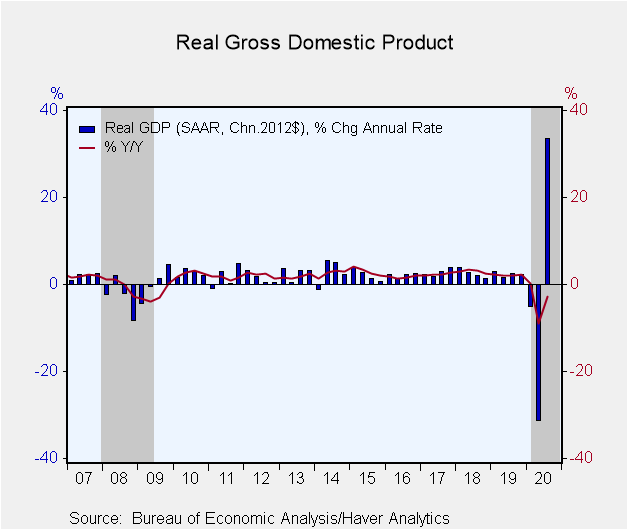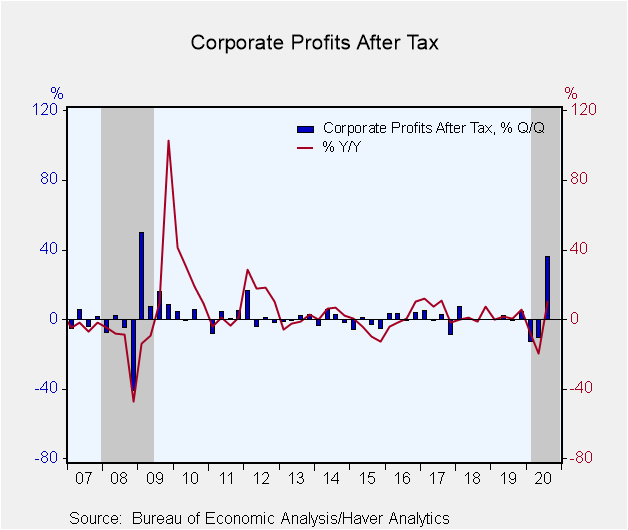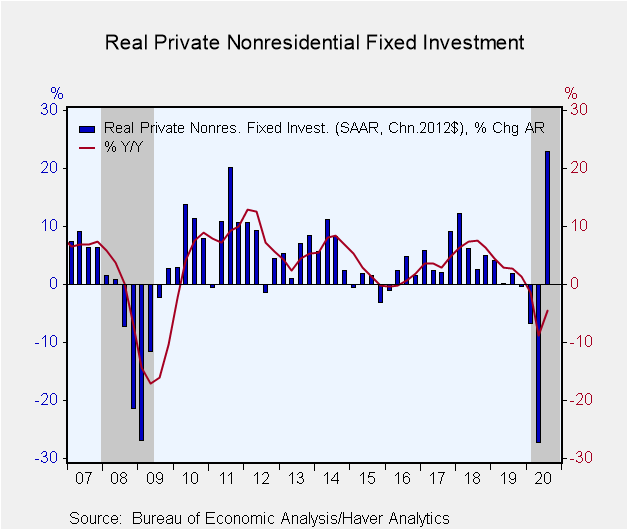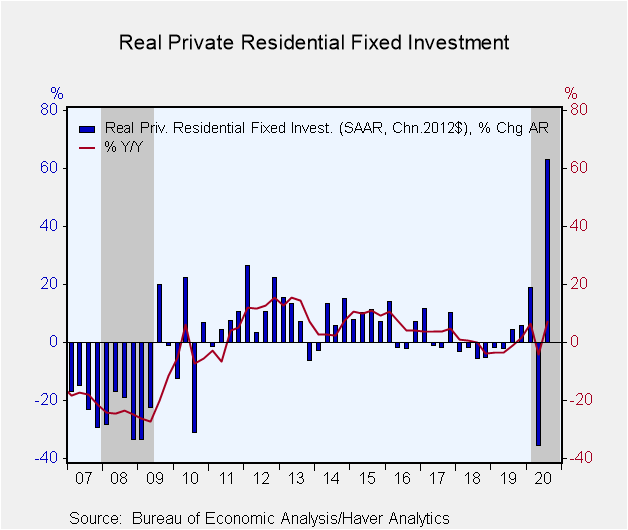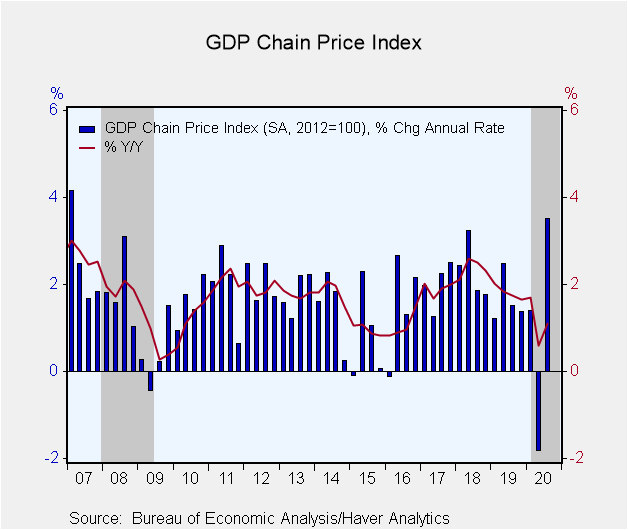 Global| Dec 22 2020
Global| Dec 22 2020U.S. GDP Growth Lifted Slightly in Q3; Corporate Profit Growth Shaved
by:Tom Moeller
|in:Economy in Brief
Summary
• Q3 GDP surge follows Q2 plunge; final demand improvement strengthened. • Record after-tax profits' rebound is reduced. • Prices improve as previously reported. U.S. real GDP rose 33.4% (SAAR) during Q3'20 (-2.8% y/y), revised from a [...]
• Q3 GDP surge follows Q2 plunge; final demand improvement strengthened.
• Record after-tax profits' rebound is reduced.
• Prices improve as previously reported.
U.S. real GDP rose 33.4% (SAAR) during Q3'20 (-2.8% y/y), revised from a 33.1% gain previously indicated. This remained a record quarterly increase, dating back to 1947, although it followed a record 31.4% drop during the second quarter. The Action Economics Forecast Survey expected a 33.1% rise. Combined with the 5.0% decline during the first quarter, GDP remained 3.4% below Q4 2019.
The rise in Q3 domestic final sales was revised to 29.8% (-2.1% y/y) from 29.4% as the rebound in consumer spending was revised to 41.0% (-2.8% y/y) from 40.6%. Nonresidential business fixed investment growth was revised up to 22.9% (-4.5% y/y) from 21.8%. Residential investment increased 63.0% (7.2% y/y), previously 62.3%.
The 4.8% decline (+0.3% y/y) in government spending last quarter was little revised. State and local government spending fell 3.9% (-1.7% y/y) compared to a 4.0% decline reported last month. It remained the second consecutive quarterly decline, leaving spending 2.3% below the Q1 peak. A 6.2% decline (+3.6% y/y) in federal government spending followed a 16.5% Q2 jump that was driven by a 37.6% surge in nondefense outlays.
Inventory liquidation subtracted an unrevised 6.6 percentage points from GDP in Q3. Foreign trade deficit widening subtracted an unchanged 3.2 percentage points. Exports surged 59.6% (-14.6% y/y) after a 64.4% weakening in Q2 while imports rose 93.0% (-8.6% y/y) following three straight quarters of sharp decline.
Corporate profits before tax with inventory valuation (IVA) and capital consumption adjustments (CCA) rose 27.4%, not annualized (3.5% y/y). This followed the previous two quarters of double-digit decline. After-tax profits without IVA and CCA jumped 36.1% (10.3% y/y), revised from 36.6%, following sharp declines in three of the prior four quarters.
The GDP, PCE and core PCE price indices were all unrevised at 3.6%, 3.7% and 3.5% respectively in Q3. Year-on-year growth of all these measures remained well below the Fed's 2% target.
The GDP figures can be found in Haver's USECON and USNA database. USNA contains virtually all of the Bureau of Economic Analysis' detail in the national accounts. Both databases include tables of the newly published not seasonally adjusted data. The Action Economics consensus estimates can be found in AS1REPNA.
| Chained 2012 $ (%, AR) | Q3'20 (3rd Estimate) | Q3'20 (2nd Estimate) | Q3'20 (Advance Estimate) | Q2'20 | Q1'20 | Q3'20 Y/Y | 2019 | 2018 | 2017 |
|---|---|---|---|---|---|---|---|---|---|
| Gross Domestic Product | 33.4 | 33.1 | 33.1 | -31.4 | -5.0 | -2.8 | 2.2 | 3.0 | 2.3 |
| Inventory Effect (%-point) | 6.6 | 6.6 | 6.6 | -3.5 | -1.3 | -0.3 | 0.0 | 0.2 | 0.0 |
| Final Sales | 25.9 | 25.6 | 25.5 | -28.1 | -3.6 | -2.6 | 2.2 | 2.8 | 2.4 |
| Foreign Trade Effect (%-point) | -3.2 | -3.2 | -3.1 | 0.6 | 1.1 | -0.4 | -0.2 | -0.3 | -0.2 |
| Domestic Final Sales | 29.8 | 29.4 | 29.2 | -27.1 | -4.6 | -2.1 | 2.3 | 3.0 | 2.5 |
| Demand Components | |||||||||
| Personal Consumption Expenditure | 41.0 | 40.6 | 40.7 | -33.2 | -6.9 | -2.8 | 2.4 | 2.7 | 2.6 |
| Nonresidential Fixed Investment | 22.9 | 21.8 | 20.3 | -27.2 | -6.7 | -4.5 | 2.9 | 6.9 | 3.7 |
| Residential Investment | 63.0 | 62.3 | 59.3 | -35.5 | 19.0 | 7.2 | -1.7 | -0.6 | 4.0 |
| Government Spending | -4.8 | -4.9 | -4.5 | 2.5 | 1.3 | 0.3 | 2.3 | 1.8 | 0.9 |
| Chain-Type Price Index | |||||||||
| GDP | 3.6 | 3.6 | 3.6 | -1.8 | 1.4 | 1.1 | 1.8 | 2.4 | 1.9 |
| Personal Consumption Expenditure | 3.7 | 3.7 | 3.7 | -1.6 | 1.3 | 1.2 | 1.5 | 2.1 | 1.8 |
| Less Food & Energy | 3.5 | 3.5 | 3.5 | -0.8 | 1.6 | 1.4 | 1.7 | 2.0 | 1.7 |
| Nonresidential Invest. | 0.1 | 0.1 | 0.2 | 0.8 | 1.0 | 0.4 | 1.3 | 0.9 | 0.9 |
| Residential Invest. | 9.4 | 9.4 | 9.6 | 1.0 | 2.3 | 3.7 | 2.8 | 5.6 | 4.5 |
| After-Tax Corporate Profits (%) | 36.1 | 36.6 | -- | -10.5 | -13.1 | 10.3 | 1.8 | 1.7 | 7.0 |
Tom Moeller
AuthorMore in Author Profile »Prior to joining Haver Analytics in 2000, Mr. Moeller worked as the Economist at Chancellor Capital Management from 1985 to 1999. There, he developed comprehensive economic forecasts and interpreted economic data for equity and fixed income portfolio managers. Also at Chancellor, Mr. Moeller worked as an equity analyst and was responsible for researching and rating companies in the economically sensitive automobile and housing industries for investment in Chancellor’s equity portfolio. Prior to joining Chancellor, Mr. Moeller was an Economist at Citibank from 1979 to 1984. He also analyzed pricing behavior in the metals industry for the Council on Wage and Price Stability in Washington, D.C. In 1999, Mr. Moeller received the award for most accurate forecast from the Forecasters' Club of New York. From 1990 to 1992 he was President of the New York Association for Business Economists. Mr. Moeller earned an M.B.A. in Finance from Fordham University, where he graduated in 1987. He holds a Bachelor of Arts in Economics from George Washington University.


